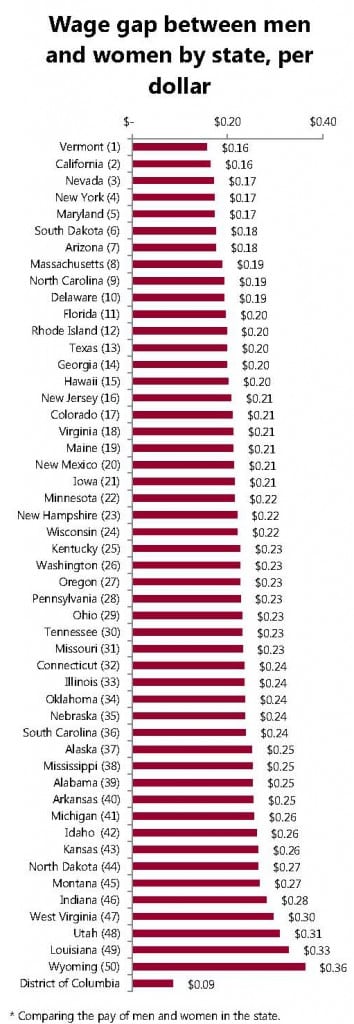 Don’t believe that the gender wage gap exists? Don’t believe it really matters? New statistics provide some startling proof and perspective.
Don’t believe that the gender wage gap exists? Don’t believe it really matters? New statistics provide some startling proof and perspective.
Today is Equal Pay Day, so let’s take a look at some statistics that really put the gender wage gap into perspective from a recent report by the National Partnership for Women & Wage Families.
Nationally, women are paid 77 cents for every dollar paid to men, which amounts to a yearly wage gap of $10,784 between full-time working men and women. The size of the wage gap varies from its lowest in Vermont where women make 84 cents for every dollar that men make to its highest in Wyoming where women make just 64 cents for every dollar that men make. You can see the full chart to the right.
The gender wage gap for a woman working full-time and year-round equates to:
- 92 weeks of food (that’s 1.8 years)
- 7 months of mortgage and utilities payments
- 13 months of rent
- 35 months of family health insurance premiums (that’s 2.9 years)
- 2,751 gallons of gas
The wage gap isn’t isolated to a certain career, industry, or education level. It exists across the board. In fact, the gap gets bigger as a woman’s education increases. For example, women with doctoral degrees are paid less than men with master’s degrees, and women with master’s degrees are paid less than men with bachelor’s degrees. Overall, women with professional degrees are paid just 67 cents for every dollar paid to men with professional degrees.
The report also cites a Government Accountability Office study which discusses the fact that women with children are paid 2.5% less than women without children, but men with children are paid 2.1% more than men without children. In essence, the study found that working mothers actually pay a “penalty” for having children while working fathers get a bonus. Is this the case across the board and in every company? Of course not, but the Government Accountability Office found the practice to be common enough to report it.
Considering that 14,998,476 households in the United States are headed by women and 29.4% of those households (4,409,552) live below the pottery level, the Paycheck Fairness Act is definitely something that all Americans should be concerned with. Fortunately, recent polls show that 81% of men and 87% of women support the new law.
You can follow the link to read the complete Working Women and the Wage Gap report and learn more about the Paycheck Fairness Act. You can also find additional reports by state, for African American women, and for Latina women on the National Partnership for Women & Families website. And next time someone tells you the wage gap doesn’t exist, show them the report. It’s hard to argue with numbers, particularly when they’re put into tangible terms using references to food, rent, mortgages, health benefits, and gas.




